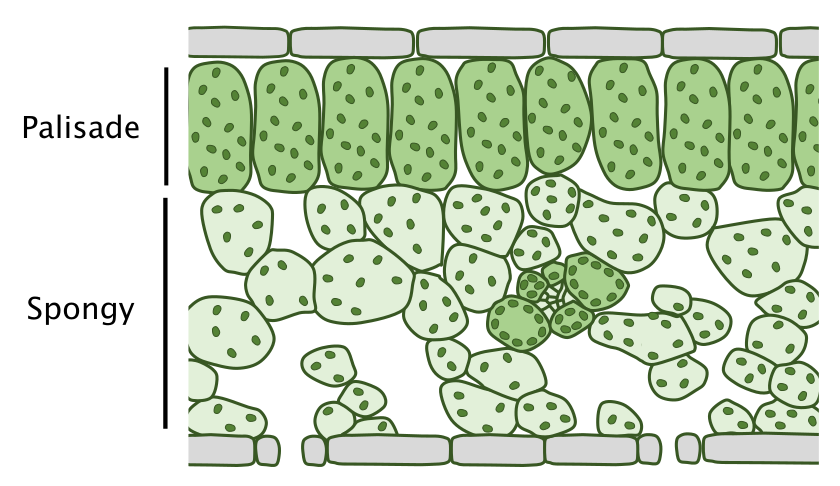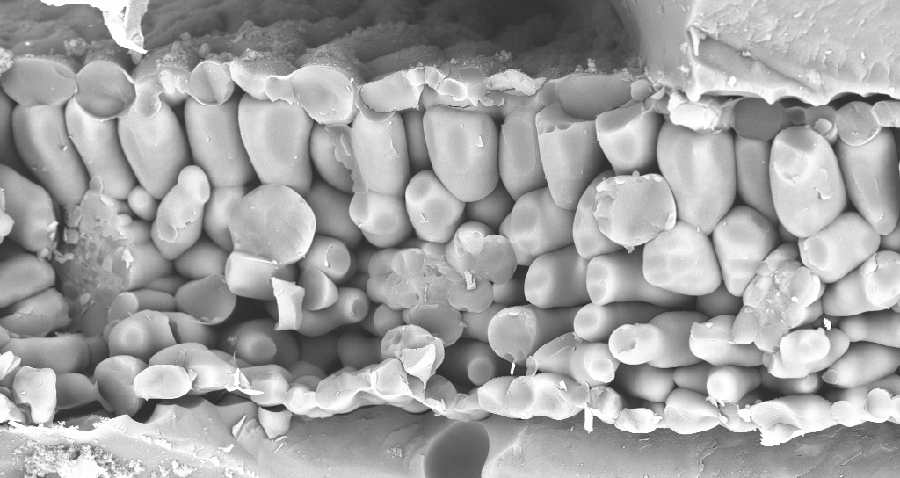
Cross section of an Arabidopsis thaliana leaf showing the two layers of photosynthetic tissue – the palisade (more tightly packed cells in upper half) and spongy mesophyll (randomly spaced irregular shaped cells in lower half). Image by Emilio Aldorino.
Identifying the master regulators of photosynthetic cell identity
SLCU’s Chris Whitewoods has received a BBSRC Pioneer Award to advance our understanding of the formation of internal leaf structure and to explore the potential for engineering plants with higher photosynthesis and water use efficiency.
Plants efficiently convert sunlight to energy and their leaves have evolved to trap light under various environmental conditions, such as in shade or during cloudy days.
They are so efficient at capturing light that plants are inspiring the design of next generation photovoltaic solar panels for use in urban environments where access to direct sunlight might be limited.
It is the internal structure of leaves that underpins this efficient system. To make photosynthesis more efficient many plants subdivide their photosynthetic cells into two types:
- Palisade mesophyll cells: Tightly-packed light trapping layer of elongated, chloroplast-dense cells on the upper half of the leaf blade, and
- Spongy mesophyll cells: Loosely-packed irregularly-shaped cells surrounded by intercellular air spaces on the lower half of the leaf blade that enhance light scattering and gas exchange.
Diagram of a leaf cross section showing location of palisade and spongy mesophyll cells. Graphic by Chris Whitewoods.
Despite being vital to photosynthesis and forming a fundamental part of plant structure, how plants control the development of palisade and spongy mesophyll cells is largely unknown. The current theory is that leaf blade formation and photosynthetic cell specification are inextricably linked — that blade outgrowth always occurs at the boundary between spongy and palisade mesophyll cells.
Dr Whitewoods’ project aims to identify the master regulators of spongy and palisade mesophyll cell identity by developing mutant Arabidopsis thaliana plants lacking palisade and spongy mesophyll cells. “As some species can form leaf blades without the two major photosynthetic cell types, we hypothesise that spongy and palisade mesophyll cell fate are specified independently of overall leaf blade growth” he said.
“To test this, we aim to identify genes controlling the identity the spongy and palisade mesophyll cells. Identifying master regulators of photosynthetic cell fate will be a major advance in fundamental biology and will also allow us to better understand the roles of palisade and spongy mesophyll cells as well as opening the door to modifying photosynthetic cell type to enhance photosynthesis.”
The Pioneer Award funds research into innovative, early-stage, higher-risk research with the potential to transform our understanding of biological systems. They are funded by the Biotechnology and Biological Sciences Research Council (BBSRC).
Cryo-SEM image of an Arabidopsis leaf showing epidermal cells, together with palisade and spongy mesophyll cells. Image by Raymond Wightman.







